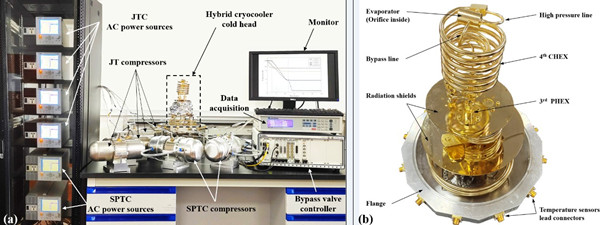- 首页 >> Research >> Research Progress
Research Progress
An important progress made in SITP (CAS) about the hybrid cryocooling cycle working in 1~2 K
Recently, a team led by Prof. Haizheng Dang in Shanghai Institute of Technical Physics (SITP) proposed a hybrid cryocooling cycle with a four-stage high frequency pulse tube cryocooling (PTC) as the precooler while a JT cycle as the final cold end, and subsequently obtained a no-load temperature of 1.36 K in the experiments, which was the lowest temperature ever reported actually achieved based on the hybrid cycle composed of the multi-stage high frequency PTC and the JT cycle.
Furthermore, in view of that all of the previous similar hybrid cycles which had actually achieved the temperatures below 2 K required to use He-3, which was rare and expensive, as the working medium in the JT subsystem, thereby causing a key bottleneck of hindering their wide application, the SITP team further proposed another novel hybrid cycle with He-4 as the only working medium in the entire system. Working together with a team led by Prof. Lixing You in Shanghai Institute of Microsystem and Information Technology (SIMIT), they put the novel hybrid cycle into practice by cooling an actual superconducting nanowire single-photon detector (SNSPD). Based on the evaluations by the measured key parameters such as the system detection efficiency (SDE) and dark count rate (DCR), it was concluded that the proposed hybrid cryocooling cycle could provide effective cooling at 1.84 K and the favourable electrical environment as well, which ensured the SNSPD to work stably and efficiently.
The above breakthrough will not only guarantee the future space application of the proposed hybrid cryocooling cycle, but also pave the way for its wide application in a variety of fields. The relevant theoretical investigations and experimental results have been published successively in Cryogenics, IEEE Transactions on Applied Superconductivity and Chinese Science bulletin.
This work is financially supported by the National Natural Science Foundation of China, Shanghai Municipal Science and Technology Major Project, Shanghai Industrial Collaborative Innovation Project and the Science and Technology Commission of Shanghai Municipality. The SITP team would like to appreciate the cooperation and support from Shanghai Research Center for Quantum Sciences, Shanghai Boreas Cryogenics Co., Ltd, SIMIT, Zhejiang PHOTEC Quantum CO., Ltd and the University of Chinese Academy of Sciences.

Figure 1. Photos of the 1~2 K hybrid cryocooler developed in SITP. (a) Experimental setup; (b) Cold ends
A list of published papers relevant to this work are given as follows:
(1).A hybrid cryocooler achieving 1.8 K and its application verification. https://engine.scichina.com/doi/10.1360/TB-2021-1305
(2). Experimental verifications of a 1.36 K hybrid cryocooler.
https://doi.org/10.1016/j.cryogenics.2022.103452
(3). Theoretical modeling of a 1 K hybrid cryocooler.
https://doi.org/10.1016/j.cryogenics.2021.103282
(4). Experimental results of a 1.52 K hybrid cryocooler.
https://doi.org/10.1109/TASC.2021.3060357
(5). Theoretical modeling of a 3.3 K four-stage PTC.
https://doi.org/10.1016/j.cryogenics.2019.103014
(6). Experimental verifications of a 3.3 K four-stage PTC.
https://doi.org/10.1016/j.cryogenics.2019.103015
(7). Theoretical and experimental investigations on a three-stage PTC.
https://doi.org/10.1016/j.cryogenics.2018.05.005
Contact:
Haizheng Dang
Shanghai Institute of Technical Physics, CAS
E-mail: haizheng.dang@mail.sitp.ac.cn
